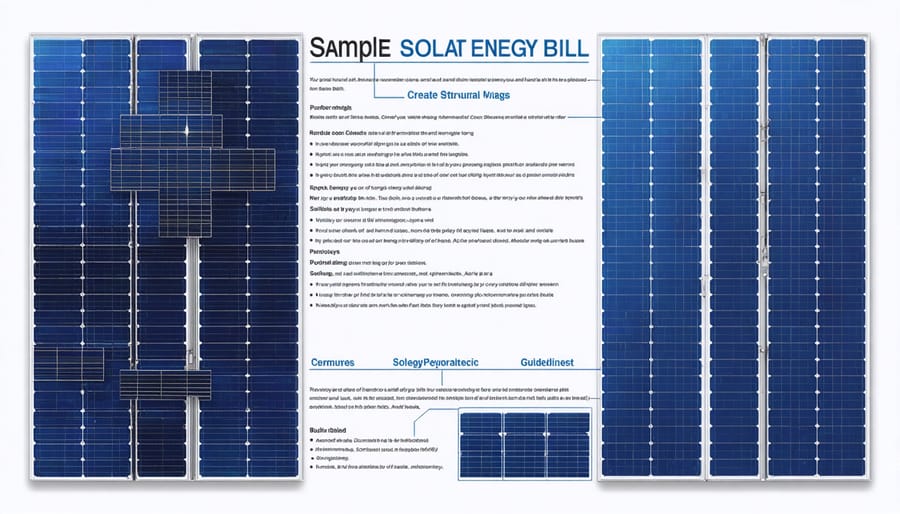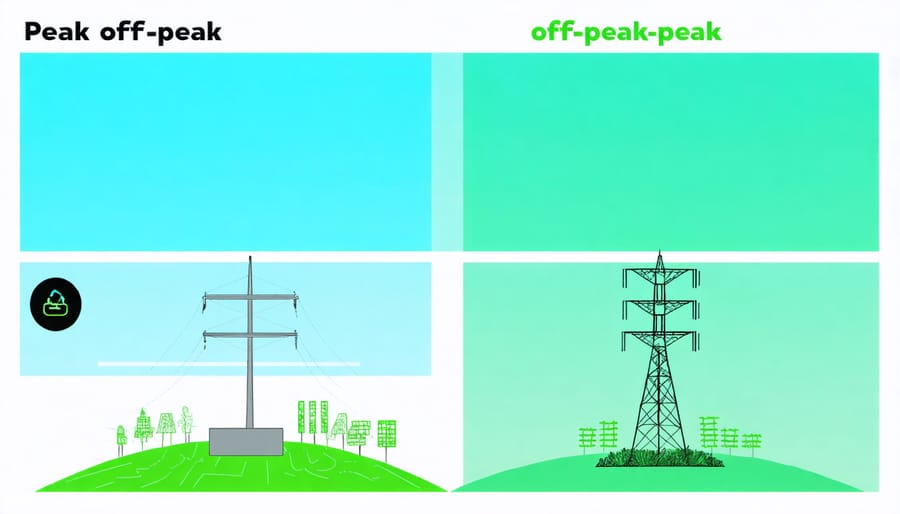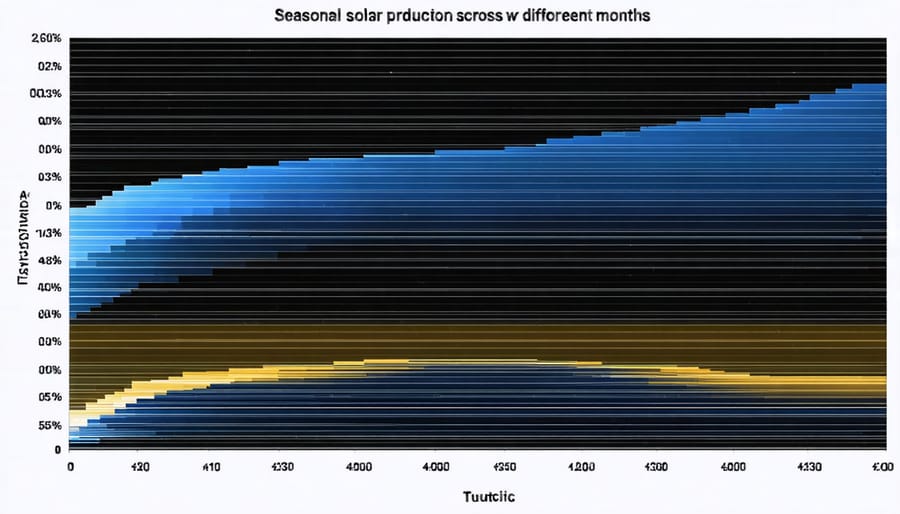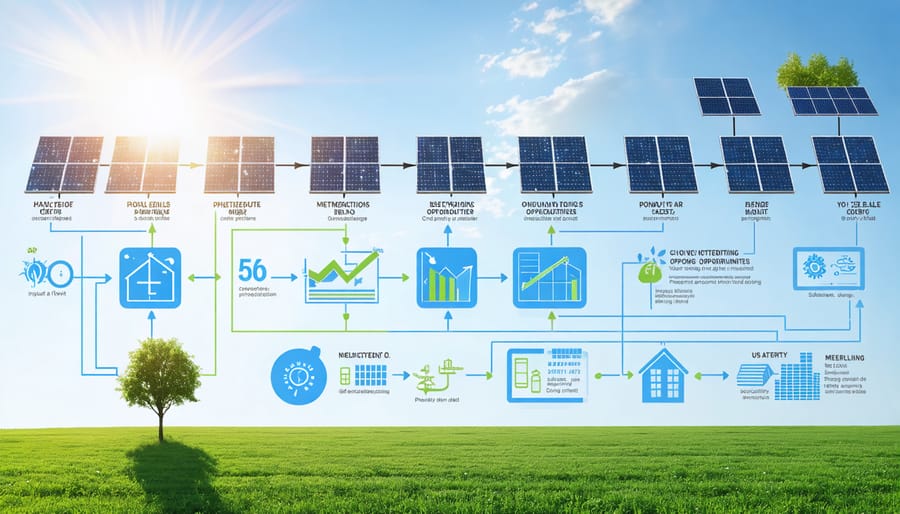Make Sense of Your Solar Bill: Expert Tips to Spot Hidden Savings
Decode your monthly solar bills with confidence and maximize your clean energy investment’s return. Understanding these statements – from net metering credits to time-of-use rates – often reveals hidden opportunities to boost savings and avoid common solar energy pitfalls. Whether you’ve just installed panels or have been generating solar power for years, a thorough bill review ensures you’re getting the full benefit of your system’s production.
Your monthly statement tells a crucial story about your solar installation’s performance, utility company credits, and overall energy consumption patterns. By learning to interpret these key metrics, you’ll spot potential issues early, optimize your energy usage, and potentially save hundreds more annually. This comprehensive guide walks you through the essential elements of your solar bill, helping you transform complex utility statements into actionable insights for better energy management and increased savings.
Think of your solar bill as a monthly report card for your clean energy investment – one that can reveal opportunities for improvement while confirming your contribution to a more sustainable future. Let’s explore how to read between the lines and ensure you’re maximizing every ray of sunshine.

Key Components of Your Solar Energy Bill
Energy Production vs. Consumption
Understanding your solar energy production and consumption metrics is key to maximizing your solar investment. Your bill typically shows two important numbers: how much energy your panels generate and how much your household consumes.
Look for your total energy production, usually measured in kilowatt-hours (kWh), which shows how much electricity your solar panels created during the billing period. This number varies with seasons, weather conditions, and panel efficiency. Next, find your home’s total energy consumption, also in kWh, which represents the electricity your household used.
To interpret these numbers effectively, compare your production against consumption. If your production exceeds consumption, you’re generating excess energy that either goes to the grid or your battery storage system. If consumption is higher, you’re drawing additional power from the grid to meet your needs.
A helpful tip is to track these numbers monthly. Create a simple spreadsheet to record both metrics, noting seasonal patterns and unusual spikes. This data helps you identify when your panels perform best and when you might need to adjust your energy usage habits.
For example, if you notice your consumption peaks during summer afternoons, you might shift energy-intensive activities like laundry to morning hours when your panels are actively producing power. This simple adjustment can help you make the most of your solar system’s output.
Net Metering Credits
Net metering credits are like a savings account for your excess solar energy. When your panels produce more electricity than you’re using, that surplus energy flows back to the grid, and you earn credits on your utility bill. These credits typically appear as a negative number or separate line item on your monthly statement.
Understanding these credits is straightforward once you know what to look for. Your bill will show both the energy you consumed from the grid and the excess energy your system exported. The credits are usually valued at the retail rate of electricity, meaning you get credited the same amount you would pay for consuming that power.
For example, if your solar panels generated 1,000 kWh in a month, but you only used 800 kWh, you’d earn credits for the extra 200 kWh. These credits can offset your future electricity costs, especially during less sunny periods or when your energy consumption is higher.
Most utilities allow you to carry these credits forward month to month, though policies vary by region. Some roll over indefinitely, while others expire annually. It’s worth checking your specific utility’s net metering policy to understand how long your credits last and how they’re calculated.
Keep track of your credits monthly to ensure they’re being properly applied and to optimize your energy usage patterns accordingly.
Common Solar Billing Issues to Watch For
Incorrect Rate Applications
One of the most common issues solar homeowners face is incorrect rate applications on their electricity bills. To spot these errors, start by comparing your current bill with previous ones, looking for unexplained rate changes or unusual charges. Your solar rate plan should match what you initially signed up for, whether it’s net metering, time-of-use, or another specialized solar rate structure.
Pay special attention to peak and off-peak rates if you’re on a time-of-use plan. Sometimes, utilities mistakenly apply standard residential rates instead of solar-specific rates, which can significantly impact your savings. Check that your net metering credits are being calculated correctly – they should reflect the full retail rate or the agreed-upon compensation rate in your area.
Another red flag is when minimum charges or fixed fees suddenly increase without prior notification. Keep copies of your original rate agreement and any utility communications about rate changes. If you notice discrepancies, document them with screenshots or copies of your bills.
Common calculation errors include:
– Incorrect solar production credits
– Missing peak/off-peak rate differentials
– Double-charging for grid electricity
– Improper baseline allocation
– Miscalculated connection fees
If you spot any of these issues, contact your utility provider immediately and request a billing review. Most utilities have dedicated solar customer service representatives who can help resolve these matters.
System Performance Indicators
Understanding your system’s performance indicators is crucial for maximizing your solar investment. Start by monitoring your energy production metrics, which typically include daily, monthly, and annual power generation figures. These numbers should align with your system’s rated capacity and expected solar panel performance over time.
Key metrics to track include peak power output (measured in kilowatts), total energy generation (in kilowatt-hours), and system efficiency percentage. Most modern solar installations come with monitoring apps or web portals that display these figures in real-time. Pay special attention to your performance ratio, which compares actual energy production against theoretical maximum output.
Look for patterns in your system’s daily performance curve. A healthy system typically shows a bell-shaped production curve during daylight hours, with peak generation occurring around midday. Sudden dips or irregular patterns might indicate issues requiring attention.
Weather conditions significantly impact performance, so cross-reference your production data with local weather records. This helps distinguish between normal weather-related fluctuations and potential system problems. Keep a monthly log of these indicators to spot trends and seasonal variations, making it easier to identify when your system might need maintenance or cleaning.
Maximizing Your Solar Investment
Peak Usage Management
Managing your peak energy usage is crucial for maximizing savings on your solar investment. By understanding and adjusting your consumption patterns, you can achieve optimal solar system performance and reduce your electricity bills significantly.
Start by identifying your peak usage hours through your smart meter or solar monitoring system. Most households experience highest energy consumption during morning and evening hours. To optimize your solar benefits, try shifting energy-intensive activities like running the dishwasher, doing laundry, or charging electric vehicles to peak sunlight hours (typically 10 AM to 3 PM).
Consider these effective strategies:
– Use timer functions on appliances to automatically run during solar production hours
– Install smart home devices to automate energy usage based on solar generation
– Pre-cool or pre-heat your home during peak solar production
– Schedule pool pumps and irrigation systems for daylight operation
– Charge devices and power banks during maximum solar generation
Remember to regularly review your consumption patterns and adjust your routine seasonally. Small changes in your daily habits can lead to substantial savings over time. Many solar users report 20-30% additional savings just by aligning their energy use with solar production schedules.

Seasonal Adjustments
Solar energy production naturally fluctuates throughout the year, and understanding these seasonal performance variations is crucial for managing your expectations and budget. During summer months, you’ll typically see higher solar production and lower utility bills, while winter months might require more grid electricity to supplement your needs.
To prepare for these seasonal changes, start by tracking your monthly production and consumption patterns. Many solar monitoring apps make this easy by providing detailed insights into your system’s performance. Create a simple spreadsheet to record your monthly bills, noting both solar generation and grid usage.
Consider implementing these practical adjustments:
– Shift heavy energy use to peak sunlight hours during winter
– Schedule annual maintenance before winter to ensure optimal performance
– Adjust your budget to account for higher winter bills
– Take advantage of net metering credits earned during summer
– Monitor weather forecasts to plan energy-intensive activities
Remember that your first year with solar will establish your baseline. Each subsequent year becomes easier to predict and plan for as you build historical data. Many homeowners find that setting aside summer savings helps smooth out winter expenses, creating a more manageable year-round energy budget.
Don’t be alarmed by seasonal fluctuations – they’re a normal part of solar ownership that becomes easier to navigate with experience and proper planning.

Regularly reviewing your solar bills is more than just a financial exercise – it’s a crucial step in maximizing your renewable energy investment and contributing to a sustainable future. By staying vigilant with your bill analysis, you can quickly identify potential system issues, track your energy production patterns, and make informed decisions about your energy consumption.
Remember that understanding your solar bills helps you maintain optimal system performance, ensure accurate credits and charges, and maximize your return on investment. Make it a habit to review your bills monthly, keeping detailed records of your energy production and consumption patterns. This data becomes invaluable when making future energy decisions or troubleshooting potential issues.
Consider setting calendar reminders for monthly bill reviews and maintaining a simple spreadsheet to track your solar performance over time. Share your experiences with other solar homeowners in your community – you might discover new insights or tips that could help improve your system’s efficiency.
By staying engaged with your solar investment through regular bill review, you’re not just managing your energy costs – you’re actively participating in the clean energy revolution. Remember, every kilowatt-hour of solar energy you generate and properly account for is a step toward a more sustainable future and greater energy independence.
Take pride in your role as a solar energy pioneer, and let your careful attention to bill management serve as inspiration for others considering the switch to solar power.











